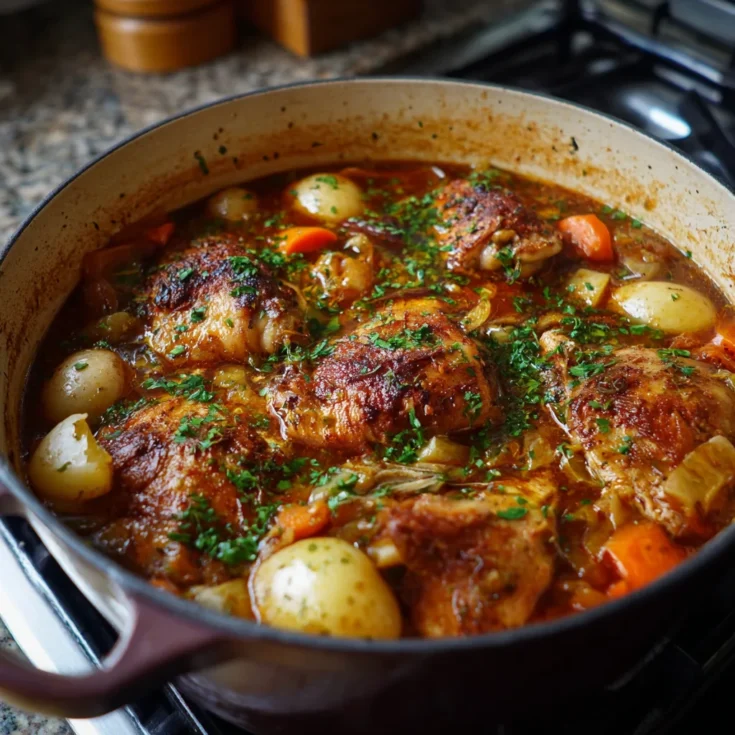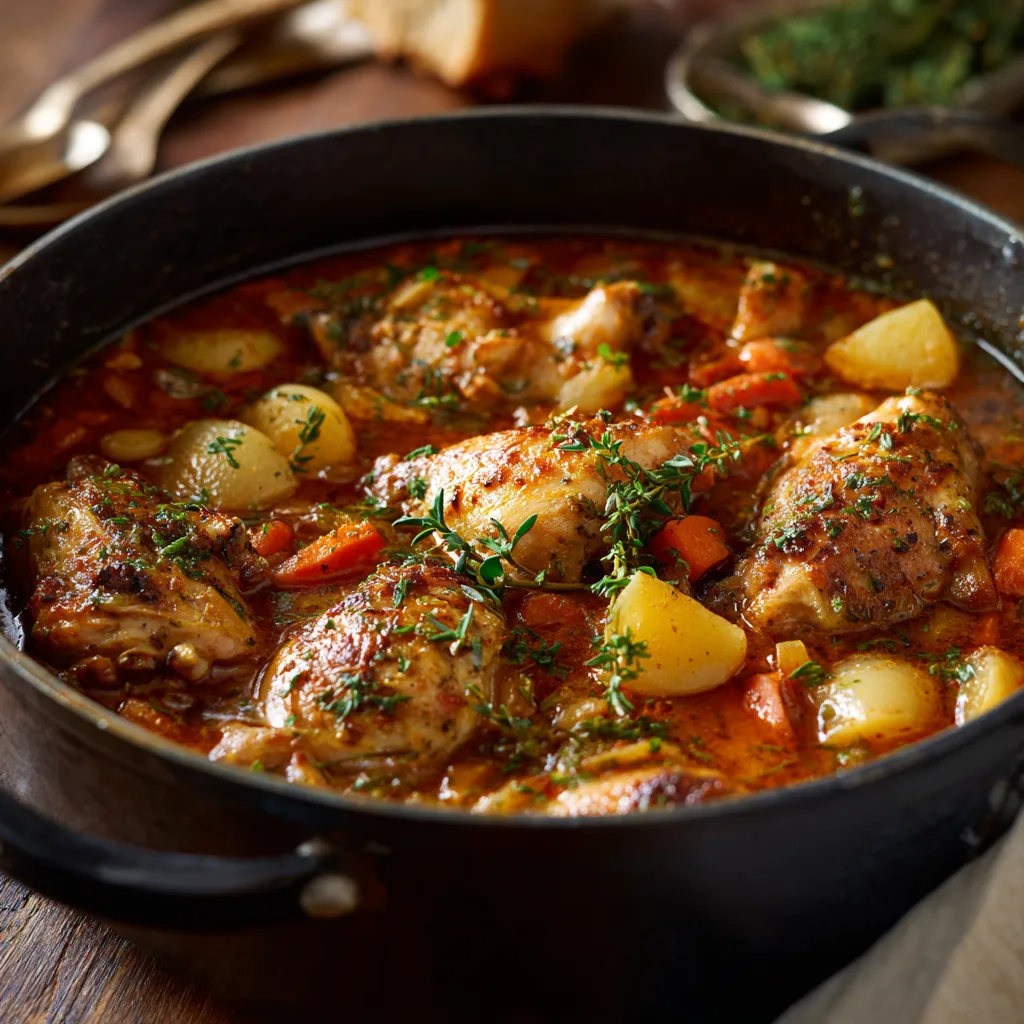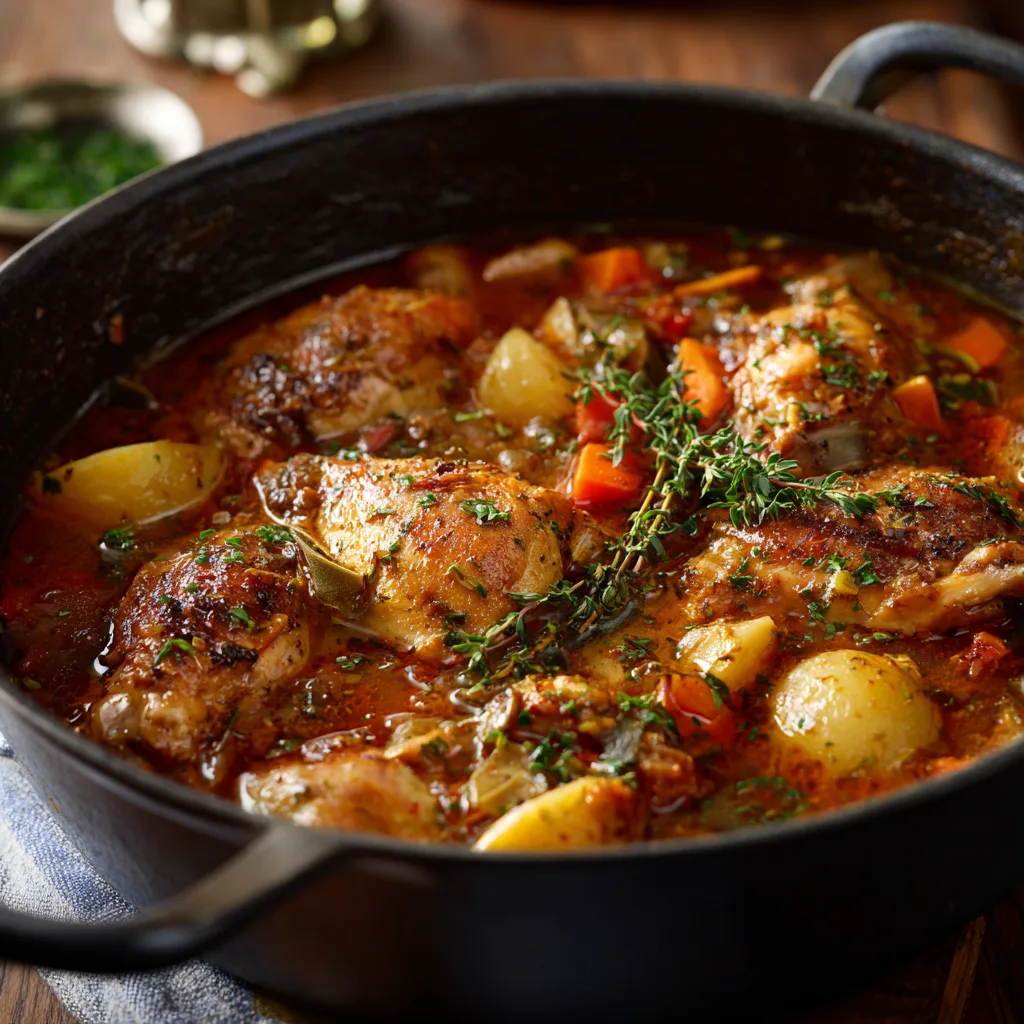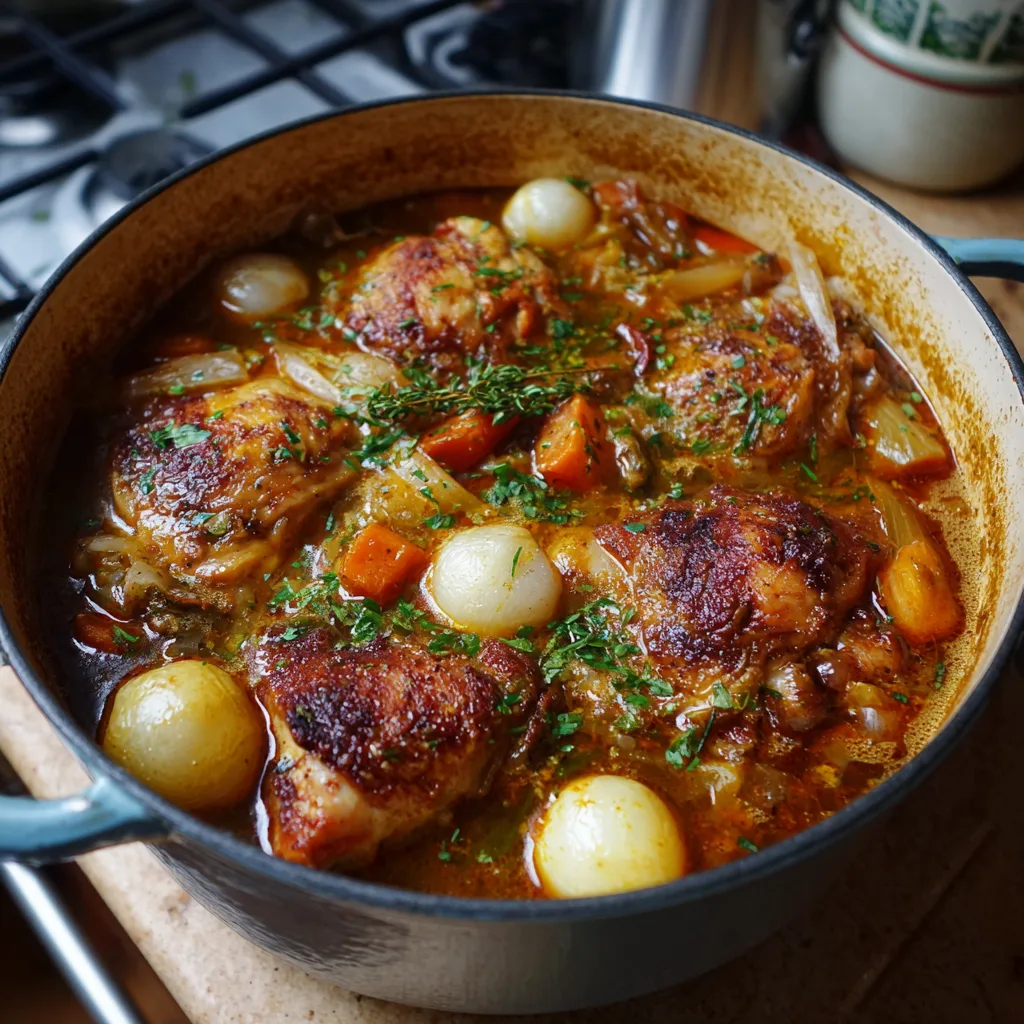One‑Pot Chicken Stew – The Ultimate Comfort Meal
One‑pot chicken stew is the kind of meal that warms you from the inside out. It combines simple ingredients with deep, savory flavor. Every spoonful delivers tender chicken, rich broth, and hearty vegetables, all cooked in a single pot. That’s the magic—minimal dishes and maximum satisfaction.
People love this recipe because it’s both wholesome and unfussy. There’s no juggling pans or long prep. Everything goes into one pot and transforms into something delicious. Whether you cook for one or for a hungry family, a cozy chicken stew never disappoints.
Why You’ll Love This Recipe
This one‑pot chicken stew is a win for busy kitchens. With just one pot, cleanup takes minutes, not hours. That means more time to relax and enjoy your meal.
It’s family‑friendly too. Kids love the soft veggies, and adults appreciate the comfort in every bite. You can easily swap ingredients based on what you have. Whether you add mushrooms or go dairy‑free, the recipe adjusts with you.
It’s also budget‑wise. Basic pantry staples like chicken, broth, and vegetables stretch into a satisfying dinner. It feeds a group or stores well for leftovers, making it practical and affordable.
Key Features That Define a Good One‑Pot Chicken Stew
A great chicken stew starts with tender, juicy meat. Chicken thighs bring extra richness and stay moist longer. Chicken breasts work too, especially when cooked gently.
The base of the stew should be flavorful. A good broth, seasoned just right, brings everything together. Add classic vegetables like carrots, celery, or potatoes for substance. Want it creamier? A splash of coconut milk or dairy-free cream works wonders. This recipe leaves room for your favorite touches while staying warm, hearty, and deeply satisfying.
Core Ingredients for the Best One‑Pot Chicken Stew
Every satisfying chicken stew begins with quality core ingredients. The chicken is your main focus. You can use boneless thighs for richness or chicken breasts for a leaner option. Bone-in cuts add depth but take longer to cook—choose what suits your time and taste.
A flavorful broth or stock sets the base. Chicken broth gives body and infuses every bite with warmth. Homemade or store-bought both work—just opt for low-sodium to control seasoning.
Mirepoix—onion, carrot, and celery—is the flavor trio in most classic stews. These vegetables soften during simmering and add subtle sweetness and depth.
Potatoes or root vegetables like parsnips or turnips provide heartiness and texture. They soak up the broth and turn tender, never bland.
Add dried herbs like thyme, bay leaves, or rosemary to layer aroma and flavor. For thickness, use flour or a slurry (water mixed with cornstarch). Either will create a silky, stew-like consistency without heavy cream.
Optional Add‑Ins and Global Inspirations for One‑Pot Chicken Stew
You can make this chicken stew your own with smart additions. Mushrooms lend an earthy tone and soak up the savory broth. A handful of peas brings a sweet pop of color and flavor. If you want creaminess, stir in a splash of plant-based milk or a touch of coconut cream near the end.
For a heartier twist, try adding diced sausage or bits of bacon. This transforms the flavor profile into something similar to Chicken Murphy—robust and full of depth.
Want global flair? Balsamic vinegar adds a touch of tang. For an Italian-inspired spin, throw in rosemary, tomatoes, and a sprinkle of parmesan at the end. A Modern Farmhouse version might include balsamic or a splash of lemon juice.
To shift eastward, use curry powder or a soy-ginger blend for a Chinese-inspired stew. These global seasonings change the base flavor but stay true to the one-pot simplicity.
Whatever direction you choose, these add-ins let you customize your stew while keeping the heart of the recipe intact.
Dietary Modifications to Fit Every Need
This one-pot chicken stew adapts easily to fit dietary preferences. For a gluten-free version, swap flour with cornstarch or arrowroot to thicken. Be sure to check that your broth is certified gluten-free too.
Need a dairy-free meal? Avoid butter and cream. Use oils like avocado or olive, and reach for unsweetened almond or oat milk if creaminess is desired.
Watching your sodium intake? Choose low-sodium broth and skip added salt until the end. Taste and season carefully.
To make it vegetarian, skip the chicken and sub in tofu or canned white beans. Add extra vegetables or mushrooms for texture. This keeps the stew hearty and satisfying, even without meat.
Best Cookware for One‑Pot Chicken Stew
To make the perfect one‑pot chicken stew, start with the right cookware. A Dutch oven is ideal. Its thick walls and heavy lid retain heat and distribute it evenly, helping flavors develop deeply. It also goes from stovetop to oven with ease.
If you don’t have a Dutch oven, a heavy-bottomed stockpot works well too. Just make sure it holds heat consistently.
Prefer hands‑off cooking? The Instant Pot delivers flavor in less time, while the slow cooker creates rich results with minimal effort. Choose based on your schedule and how much you want to supervise.
Step‑by‑Step Cooking Method for a Flavorful Stew
Begin by searing the chicken in oil over medium-high heat. This browns the surface, locking in juices and creating a rich flavor base. Remove the chicken once it’s golden on both sides.
Next, sauté your aromatics. Add diced onions, celery, and carrots to the same pot. Stir often until softened. Garlic, thyme, or rosemary can go in next—fragrant herbs build flavor early.
Once veggies are tender, return the chicken to the pot. Pour in the broth and bring to a simmer. Add a thickener like flour or cornstarch slurry to create a velvety base. Stir well to avoid lumps.
Simmer the stew gently. This step lets everything meld. Cover the pot and let it cook until the chicken is fork-tender and the vegetables are soft—about 45 minutes. In the last 10 minutes, add any quick-cooking ingredients like peas or spinach.
Taste, adjust seasoning, and serve warm. The result is a complete, deeply flavored meal.
Timing and Temperature Tips for Best Results
On the stovetop, cook the stew on low heat for 45 to 60 minutes. Keep the lid on but stir occasionally to prevent sticking.
In a slow cooker, set it to low and cook for 7 to 8 hours. For quicker results, use the high setting for 3 to 4 hours.
Using an Instant Pot? Set it to pressure cook for about 15 minutes, then allow natural release for 10 minutes. This method speeds up cooking without sacrificing depth of flavor.
Serving Suggestions for One‑Pot Chicken Stew
One‑pot chicken stew is versatile and satisfying on its own, but smart pairings elevate the experience. Serve it over steamed rice, cauliflower rice, or a light mashed potato base to soak up every bit of the savory broth. For a lighter touch, a crisp green salad on the side balances the stew’s warmth with fresh texture.
Want to impress? Add crusty bread—a warm baguette or rustic sourdough—to mop up the juices. Garnish with chopped parsley for color and brightness. For extra flair, try a spoonful of gremolata or top with crispy chicken skin saved from earlier.
These simple additions enhance both presentation and flavor while keeping the stew at the center of the plate.
Leftovers and Storage
Chicken stew stores well, making it ideal for leftovers. Let the stew cool completely before transferring it to airtight containers. In the refrigerator, it stays fresh for up to 3 to 4 days. Reheat only what you need to maintain quality.
For freezing, portion the stew into freezer‑safe containers or bags. Label with the date, then freeze for up to 3 months. Thaw overnight in the fridge before reheating.
When it’s time to eat, reheat gently on the stovetop over medium-low heat, stirring occasionally. This prevents overcooking and maintains the stew’s texture. The microwave works well too—use short intervals and stir between rounds to ensure even warmth.
Leftover chicken stew often tastes even better the next day, as the flavors continue to meld.
Make‑Ahead and Batch Cooking Tips
Planning ahead? This stew is perfect for batch cooking. Simply double the recipe and divide into meal-sized portions. You can freeze individual servings for quick lunches or dinners.
For best results, slightly undercook vegetables before freezing. This prevents them from becoming mushy when reheated.
When reheating from frozen, let the container sit at room temperature for 30 minutes, or thaw in the refrigerator overnight. Warm on the stovetop slowly to preserve flavor and consistency.
This approach saves time while keeping your meals wholesome and homemade.
Frequently Asked Questions
Can I use chicken breast instead of thighs?
Yes, chicken breast works, but expect slight differences. Thighs offer more flavor and remain tender during simmering. Breasts cook faster and can dry out if overdone. To prevent that, cut breasts into even pieces and add them later in the cooking process.
How do I thicken the stew properly?
You have options. For a classic method, use a flour roux by cooking equal parts flour and fat before adding liquid. For a quicker solution, stir in a cornstarch slurry (1 tbsp cornstarch + 2 tbsp water). Or, let the stew reduce uncovered to naturally thicken over time.
What’s the best way to adapt for dietary restrictions?
For gluten-free needs, avoid flour-based roux and use cornstarch or arrowroot. Skip dairy-based add-ins like cream or butter for dairy-free versions. Vegetarians can swap chicken for hearty plant proteins like lentils or tofu and use vegetable broth instead of chicken stock.
Can I make this in an Instant Pot or slow cooker?
Absolutely. In an Instant Pot, sauté ingredients first, then pressure cook for 15 minutes with a natural release. For the slow cooker, set it on low for 7–8 hours or high for 3–4. Always sauté aromatics beforehand for maximum flavor.
How do I prevent veggies from turning mushy?
Timing is key. Add root vegetables early, but save tender ones like zucchini or spinach for the final 10 minutes. Cut veggies into uniform, larger chunks to withstand the simmering without losing texture.
Hearty One-Pot Chicken Stew – Cozy, Easy & Family-Approved

A cozy, hearty stew packed with tender chicken, vegetables, and deep savory flavor—all made in a single pot.
Ingredients
- 1 lb boneless chicken thighs or breasts, cut into chunks
- 2 tbsp olive oil
- 1 onion, diced
- 2 carrots, sliced
- 2 celery stalks, chopped
- 3 garlic cloves, minced
- 3 cups chicken broth
- 1 cup chopped potatoes (optional)
- 1 cup green beans or peas
- 1 tsp dried thyme
- Salt and pepper to taste
- 1 tbsp cornstarch + 2 tbsp water (optional for thickening)
Instructions
Notes
Troubleshooting Common Issues
Bland broth? Use a well-seasoned, high-quality stock. Salt gradually as you cook, and include umami-rich ingredients like tomato paste or garlic.
Thin stew? Thicken it with a roux, slurry, or by letting it reduce. Don’t rush—thickening takes patience.
Overcooked chicken or veggies? Watch your timing. Use a thermometer for chicken (165°F or 74°C), and stagger veggie additions based on density.




